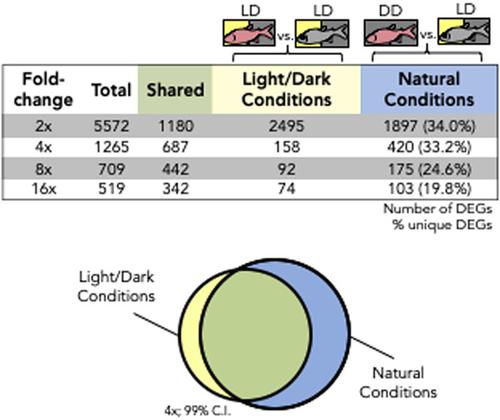当前位置:
X-MOL 学术
›
J. Exp. Zool. B Mol. Dev. Evol.
›
论文详情
Our official English website, www.x-mol.net, welcomes your
feedback! (Note: you will need to create a separate account there.)
Dark-rearing uncovers novel gene expression patterns in an obligate cave-dwelling fish.
Journal of Experimental Zoology-B: Molecular and Developmental Evolution ( IF 1.8 ) Pub Date : 2020-05-05 , DOI: 10.1002/jez.b.22947 Connor R Sears 1 , Tyler E Boggs 1 , Joshua B Gross 1
Journal of Experimental Zoology-B: Molecular and Developmental Evolution ( IF 1.8 ) Pub Date : 2020-05-05 , DOI: 10.1002/jez.b.22947 Connor R Sears 1 , Tyler E Boggs 1 , Joshua B Gross 1
Affiliation

|
Extreme environments often result in the evolution of dramatic adaptive features. The Mexican tetra, Astyanax mexicanus, includes 30 different populations of cave‐dwelling forms that live in perpetual darkness. As a consequence, many populations have evolved eye loss, reduced pigmentation, and amplification of nonvisual sensory systems. Closely‐related surface‐dwelling morphs demonstrate typical vision, pigmentation, and sensation. Transcriptomic assessments in this system have revealed important developmental changes associated with the cave morph, however, they have not accounted for photic rearing conditions. Prior studies reared individuals under a 12:12 hr light/dark (LD) cycle. Here, we reared cavefish under constant darkness (DD) for 5+ years. From these experimental individuals, we performed mRNA sequencing and compared gene expression of surface fish reared under LD conditions to cavefish reared under DD conditions to identify photic‐dependent gene expression differences. Gene Ontology enrichment analyses revealed a number of previously underappreciated cave‐associated changes impacting blood physiology and olfaction. We further evaluated the position of differentially expressed genes relative to QTL positions from prior studies and found several candidate genes associated with these ecologically relevant lighting conditions. In sum, this work highlights photic conditions as a key environmental factor impacting gene expression patterns in blind cave‐dwelling fish.
中文翻译:

黑暗饲养揭示了一种专性洞穴栖息鱼类的新基因表达模式。
极端环境通常会导致戏剧性的适应性特征的演变。墨西哥 tetra, Astyanax mexicanus,包括 30 种不同的洞穴居住形式,它们生活在永恒的黑暗中。因此,许多人群已经进化出失明、色素沉着减少和非视觉感觉系统的放大。密切相关的表面居住变形表现出典型的视觉、色素沉着和感觉。该系统中的转录组学评估揭示了与洞穴形态相关的重要发育变化,但是,它们并没有考虑到光照条件。先前的研究在 12:12 小时的光/暗 (LD) 循环下饲养个体。在这里,我们在持续黑暗 (DD) 下饲养了 5 年以上的洞穴鱼。从这些实验个体中,我们进行了 mRNA 测序,并比较了在 LD 条件下饲养的表面鱼与在 DD 条件下饲养的洞穴鱼的基因表达,以确定光依赖的基因表达差异。基因本体富集分析揭示了许多以前未被充分认识的影响血液生理学和嗅觉的洞穴相关变化。我们进一步评估了差异表达基因相对于先前研究的 QTL 位置的位置,并发现了几个与这些生态相关光照条件相关的候选基因。总之,这项工作强调了光条件是影响洞穴盲鱼基因表达模式的关键环境因素。基因本体富集分析揭示了许多以前未被充分认识的影响血液生理学和嗅觉的洞穴相关变化。我们进一步评估了差异表达基因相对于先前研究的 QTL 位置的位置,并发现了几个与这些生态相关光照条件相关的候选基因。总之,这项工作强调了光条件是影响洞穴盲鱼基因表达模式的关键环境因素。基因本体富集分析揭示了许多以前未被充分认识的影响血液生理学和嗅觉的洞穴相关变化。我们进一步评估了差异表达基因相对于先前研究的 QTL 位置的位置,并发现了几个与这些生态相关光照条件相关的候选基因。总之,这项工作强调了光条件是影响洞穴盲鱼基因表达模式的关键环境因素。
更新日期:2020-05-05
中文翻译:

黑暗饲养揭示了一种专性洞穴栖息鱼类的新基因表达模式。
极端环境通常会导致戏剧性的适应性特征的演变。墨西哥 tetra, Astyanax mexicanus,包括 30 种不同的洞穴居住形式,它们生活在永恒的黑暗中。因此,许多人群已经进化出失明、色素沉着减少和非视觉感觉系统的放大。密切相关的表面居住变形表现出典型的视觉、色素沉着和感觉。该系统中的转录组学评估揭示了与洞穴形态相关的重要发育变化,但是,它们并没有考虑到光照条件。先前的研究在 12:12 小时的光/暗 (LD) 循环下饲养个体。在这里,我们在持续黑暗 (DD) 下饲养了 5 年以上的洞穴鱼。从这些实验个体中,我们进行了 mRNA 测序,并比较了在 LD 条件下饲养的表面鱼与在 DD 条件下饲养的洞穴鱼的基因表达,以确定光依赖的基因表达差异。基因本体富集分析揭示了许多以前未被充分认识的影响血液生理学和嗅觉的洞穴相关变化。我们进一步评估了差异表达基因相对于先前研究的 QTL 位置的位置,并发现了几个与这些生态相关光照条件相关的候选基因。总之,这项工作强调了光条件是影响洞穴盲鱼基因表达模式的关键环境因素。基因本体富集分析揭示了许多以前未被充分认识的影响血液生理学和嗅觉的洞穴相关变化。我们进一步评估了差异表达基因相对于先前研究的 QTL 位置的位置,并发现了几个与这些生态相关光照条件相关的候选基因。总之,这项工作强调了光条件是影响洞穴盲鱼基因表达模式的关键环境因素。基因本体富集分析揭示了许多以前未被充分认识的影响血液生理学和嗅觉的洞穴相关变化。我们进一步评估了差异表达基因相对于先前研究的 QTL 位置的位置,并发现了几个与这些生态相关光照条件相关的候选基因。总之,这项工作强调了光条件是影响洞穴盲鱼基因表达模式的关键环境因素。











































 京公网安备 11010802027423号
京公网安备 11010802027423号